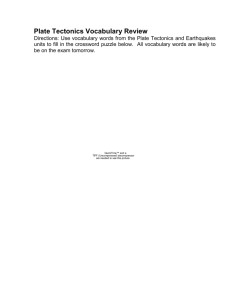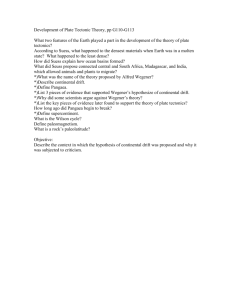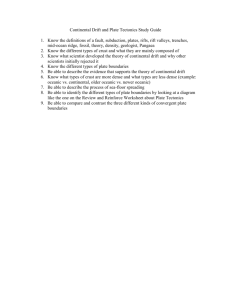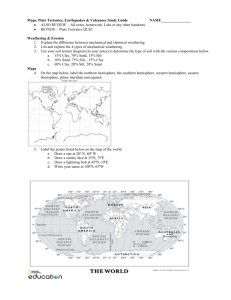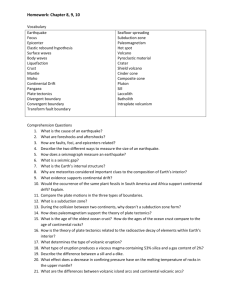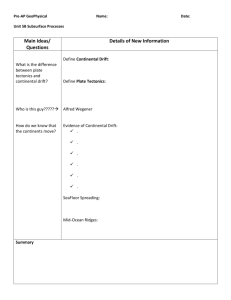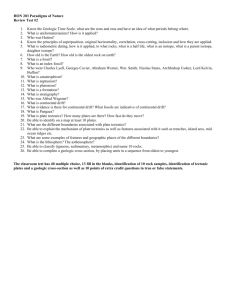Answer
advertisement
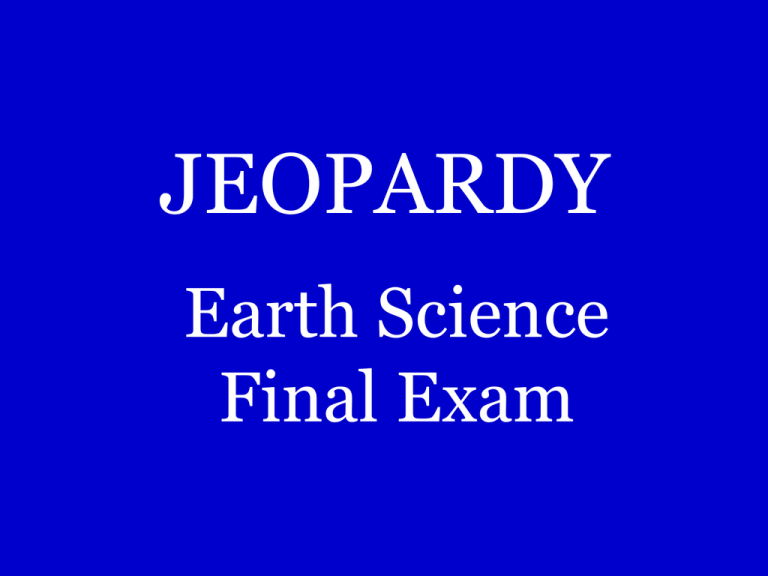
JEOPARDY Earth Science Final Exam Plate Tectonics 0 Continental Drift Earthquakes 0 Historical Geology Relative & Absolute Dating Weather & Climate 100 100 100 100 100 100 200 200 200 200 200 200 300 300 300 300 300 300 400 400 400 400 400 400 500 500 500 500 500 500 600 600 600 600 600 600 JEOPARDY! JEOPARDY! 0 Plate Tectonics 100 Which of the following statements about the continental crust is true? A. It is made of dense rocks like granite. B. It is made of light materials like silt and clay. C. It is about 7-10 km thick. D. It is molten. Plate Tectonics 100 A. It is made of dense rocks like granite. Plate Tectonics 200 Where can we find evidence that the north and south magnetic poles have reversed positions several times in Earth’s history? A. The Appalachian Mountains B. Antarctica’s fossils C. Mid-Atlantic Ridge D. Ring of Fire Plate Tectonics 200 C. Mid-Atlantic Ridge Plate Tectonics 300 What happens to the old crust that was originally near the mid-ocean ridge? A. It melts immediately and sinks into the mantle. B. It folds into underwater mountains. C. It forms a deep sea trench. D. It is pushed aside by the new crust. Plate Tectonics 300 D. It is pushed aside by the new crust. Plate Tectonics 400 ALL of the following are evidence that support Wegener’s hypothesis of continental drift EXCEPT A. Fossils of prehistoric plants and animals found on South America and Africa. B. Mountain ranges on different continents line up. C. Coastline shapes of continents fit like jigsaw puzzle pieces. D. Convection currents in the mantle move plates. Plate Tectonics 400 D. Convection currents in the mantle move plates. Plate Tectonics 500 We know that the Atlantic Ocean is continuously expanding. What’s stopping it from expanding and taking over the entire world? A. Reduction B. Ridging C. Subduction D. Trenching Plate Tectonics 500 C. Subduction Plate Tectonics 600 What is happening to the Pacific Ocean while the Atlantic Ocean is expanding? A. B. C. D. It is getting slowly smaller. It is also expanding. It has developed many island arcs. It has collided with the African plate. Plate Tectonics 600 A. It is getting slowly smaller. Continental Drift 100 Which point in the continental drift sequence is shown? A. 250 million years ago (First) B. 195 million years ago (Second) C. 132 million years ago (Third) D. 60 million years ago (Fourth) E. Modern world (Fifth/The Present) Continental Drift 100 A. 250 million years ago (First) Continental Drift 200 Which point in the continental drift sequence is shown? A. 250 million years ago (First) B. 195 million years ago (Second) C. 132 million years ago (Third) D. 60 million years ago (Fourth) E. Modern world (Fifth/The Present) Continental Drift 200 B. 195 million years ago (Second) Continental Drift 300 Which point in the continental drift sequence is shown? A. 250 million years ago (First) B. 195 million years ago (Second) C. 132 million years ago (Third) D. 60 million years ago (Fourth) E. Modern world (Fifth/The Present) Continental Drift 300 E. Modern world (Fifth/The Present) Continental Drift 400 What type of plate boundary is shown? A. Converging—Collision B. Converging—Subduction/ Trench & Island Arc C. Converging—Subduction/ Trench & Volcanic Mountains D. Sliding/Fault E. Diverging--Ridge/Rift Continental Drift 400 B. Converging—Subduction/ Trench & Island Arc Continental Drift 500 Daily Double!!! What type of plate boundary is shown? A. Converging—Collision B. Converging— Subduction/ Trench & Island Arc C. Converging— Subduction/ Trench & Volcanic Mountains D. Sliding/Fault E. Diverging--Ridge/Rift Continental Drift 500 Daily Double!!! C. Converging—Subduction/ Trench & Volcanic Mountains Continental Drift What type of plate boundary 600 is shown? A. Converging—Collision B. Converging— Subduction/ Trench & Island Arc C. Converging— Subduction/ Trench & Volcanic Mountains D. Sliding/Fault E. E. Diverging--Ridge/Rift Continental Drift 600 D. Sliding/Fault Earthquakes 100 What does the picture show? A. B. C. D. E. epicenter focus L wave P wave S wave Earthquakes 100 D. P wave Earthquakes 200 What does the picture show? A. B. C. D. E. epicenter focus L wave P wave S wave Earthquakes 200 E. S wave Earthquakes 300 What changes the rate at which P and S waves move? A. The type and density of the material through which they travel. B. The place in the crust where they occur. C. The season of the year in which they happen. D. The distance from the focus. Earthquakes 300 A. The type and density of the material through which they travel. Earthquakes 400 The fact that S waves are unable to travel through Earth’s outer core supports the inference that the outer core is A. B. C. D. composed of iron and silica. more dense than the inner core. hotter than the rock’s melting point. in a liquid state of matter. Earthquakes 400 D. in a liquid state of matter. Earthquakes 500 This diagram shows the paths of P waves and S waves generated during an earthquake. Only P waves reach the side of the Earth that is opposite the focus because P waves… A. are stronger than S waves. B. travel faster than S waves. C. bend more than S waves. D. can travel through liquids. Earthquakes 500 D. can travel through liquids. Earthquakes 600 What role do plate boundaries play in the depths at which earthquakes occur? A. They determine the depth of the earthquake because different types of plate boundaries are associated with particular depths. B. All plate boundaries are roughly at the same depth, so all earthquakes originate at the same depth. C. Earthquakes occur only at strike-slip (transform) plate boundaries, so they can only occur at shallow depths. D. Plate boundaries do not affect earthquake depths. Earthquakes 600 A. They determine the depth of the earthquake because different types of plate boundaries are associated with particular depths. Historical Geology 100 Index fossils are used to help determine the age of rocks. All of the following characteristics describe index fossils EXCEPT A. B. C. D. alive for a short geologic time. abundant. petrified. geographically widespread. Historical Geology 100 C. petrified. Historical Geology 200 Fossils are most likely found in which type of rock? A. igneous B. intrusive C. metamorphic D. sedimentary Historical Geology 200 D. sedimentary Historical Geology 300 Fossils will most likely form in conditions of A. stable sedimentation and compression. B. organic decomposition and weathering. C. exposure to tropical climates. D. exposure to moisture and air. Historical Geology 300 A. stable sedimentation and compression. Historical Geology 400 Archaeopteryx, an early bird species, had dinosaur features; but, it also had feathers. This fossil… A. supports the theory that birds and reptiles have different ancestors. B. refutes the theory that mammals and reptiles are related. C. refutes the theory that dinosaurs were warm-blooded. D. supports the theory that birds evolved from dinosaurs. Historical Geology 400 D. supports the theory that birds evolved from dinosaurs. Historical Geology 500 Of the following, which is the most likely to leave a good fossil record? A. B. C. D. amoeba trilobite flatworm herbaceous plant Historical Geology 500 B. trilobite Historical Geology 600 Which of the following are two ways that original remains can occur? (Choose both answers.) A. An insect or very small animal is trapped in amber. B. A dinosaur falls into a mud pit and is gradually pressed into a mold of the sedimentary rock. C. A prehistoric bird’s egg is buried in the nest and gradually replaced with calcium carbonate. D. A baby woolly mammoth falls into a crack in a glacier and is frozen with ice and snow. Historical Geology 600 A. An insect or very small animal is trapped in amber. D. A baby woolly mammoth falls into a crack in a glacier and is frozen with ice and snow. Relative & Absolute Dating 100 According to the law of superposition, which strata is most likely older: B, C, D, or E? Relative & Absolute Dating 100 B Relative & Absolute Dating 200 According to the law of cross-cutting, which strata is most likely younger: A, B, C, or D? Relative & Absolute Dating 200 A Relative & Absolute Dating 300 Which side of the diagram represents absolute time? Side A Side B Side A Side B Relative & Absolute Dating 300 Side B Relative & Absolute Dating 400 The dating of volcanic ash layers is used as A. Horizontality. B. Index fossils. C. Cross-cutting. D. Key Beds. Relative & Absolute Dating 400 D. Key Beds Relative & Absolute Dating 500 Which era ended with a mass extinction possibly caused by an asteroid strike? A. Cenozoic B. Mesozoic C. Paleozoic Relative & Absolute Dating 500 B. Mesozoic Relative & Absolute Dating 600 Which of the following are the two problems with Carbon14 dating? Choose both answers. A. Long half-life: It breaks down into Sodium9 and is too dangerous to use. B. Short half-life: Can’t date back far in time. C. Can only be used on things that were once living (organic=wood, bones). D. Can only be used on rocks. Relative & Absolute Dating 600 B. Short half-life: Can’t date back far in time. C. Can only be used on things that were once living (organic=wood, bones). Weather & Climate 100 Which of these map symbols is for a A. warm front? B. C. Weather & Climate 100 B. Weather & Climate 200 A. B. C. D. E. All of the following are factors that help determine climate EXCEPT… altitude/elevation latitude longitude nearness to large body of water prevailing winds Weather & Climate 200 C. longitude Weather & Climate 300 What does it mean when the isobar lines are close together on a weather map? A. High pressure B. High elevation C. Low pressure D. Low elevation Weather & Climate 300 C. Low pressure Weather & Climate 400 What factors may make it difficult to predict the weather in our area? Choose the 3 factors that affect our forecasts. A. altitude/elevation variations between nearby mountains, valleys, and plains B. variations in soil types that slow down evaporation C. abundant plant life and vegetation D. nearness to the Chesapeake Bay and Atlantic Ocean E. prevailing winds over the Blue Ridge mountains Weather & Climate 400 A. altitude/elevation variations between nearby mountains, valleys, and plains D. nearness to the Chesapeake Bay and Atlantic Ocean E. prevailing winds over the Blue Ridge mountains Weather & Climate 500 An air mass moving south from central Canada toward the Midwest section of the United States would most likely be A. wet and cool B. wet and fast C. humid and frigid D. dry and cool Weather & Climate 500 D. dry and cool Weather & Climate 600 In which of the following air masses do most hurricanes form? A. polar continental B. polar maritime C. tropical maritime D. tropical continental E. all types of air masses Weather & Climate 600 C. tropical maritime Daily Double! How much will you put on the line? Daily Double! How much will you put on the line? JEOPARDY! Click Once to Begin Template by Bill Arcuri, WCSD Modified/Adapted by Patricia Sinclair
